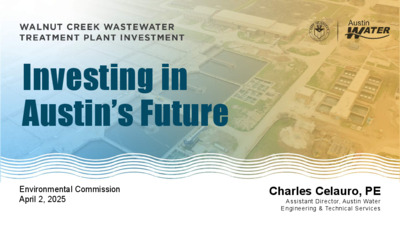20250402-003: Walnut Creek WWTP Austin Water Presentation — original pdf
Backup

Investing in Austin’s Future Environmental Commission April 2, 2025 Charles Celauro, PE Assistant Director, Austin Water Engineering & Technical Services Agenda 1. Wastewater System Overview 2. Plant History 3. Plant Upgrades 4. Walnut Creek Enhancement and Expansion 2 Balcones PP River Place PP Lost Creek PP Dessau PP OSCAR and CLARA Hornsby Bend Biosolids Mngt Plant Thoroughbred Farms PP LEGEND Regional WWTP Solids Management Plant Package Plant (PP) Brushy Creek East WWTP Expansion 3 Wildhorse PP Taylor Lane PP South Austin Regional WWTP Pearce Lane PP Wastewater by the Numbers Austin Water Statics: 2,900 Miles of Gravity Lines 59,000 Manholes 137 Lift Stations 9 Decentralized Package WWTP 1 Jointly Owned Wastewater System Brushy Creek Wastewater System; COA Ownership is 9.87% 2 Regional Wastewater Treatment Plants Walnut Creek & South Austin Regional WWTP 1 Biosolids Plant Hornsby Bend Biosolids Management Plant Walnut Creek WWTP 78 Miles of Force Mains Service Area Map 4 Walnut Creek WWTP South Austin Regional WWTP Plant History 5 Plant History WALNUT CREEK WWTP Rehabilitation and Renewal Projects 1977 – 18 MGD 6 6 Plant History WALNUT CREEK WWTP Rehabilitation and Renewal Projects 1977 – 18 MGD 1987 – 40 MGD 1990 – 60 MGD 1999 – Colorado River Outfall 2005 – 75 MGD 2019 – Optimization & Facility Plan 7 7 EC0 Plant History WALNUT CREEK WWTP Rehabilitation and Renewal Projects 2000 – Reclaimed Water 2005 – Headworks #2 2009 – Electrical Distribution 2013 – Reclaimed Water 2017 – Tertiary Filter 2019 – Secondary Treatment 2020 – Sludge Thickener 2020 – Pump Replacements 2021 – Plant Control & Network 2022 – Gas Scrubber 2025 – Primary and Flow Equalization Basin 8 Upgrading our entire process 9 The expansion will add treatment capacity of 25 million gallons per day. The existing plant is currently permitted to treat 75 million gallons per day. Flows into the plant exceeded 75 percent of its treatment capacity in 2015 and surpassed 90 percent of treatment capacity for three months in 2024. 10 Aging infrastructure will be rebuilt or replaced across the plant with new environmental and operational upgrades incorporated. Process areas to be rebuilt include: • Headworks #1 • Influent Lift Station The treatment process for the existing plant and the expansion will be upgraded to reduce nutrient levels with a Biological Nutrient Removal (BNR) process, benefiting the health of the Colorado River downstream of Austin. 11 The plant will transition from chlorine to ultraviolet (UV) light disinfection, eliminating chemicals and improving safety for workers and the community. A flood wall will be built around the plant to protect it from floodwaters that could rise from nearby Walnut Creek. 12 Mitigate odors by incorporating advanced odor control technologies, such as biofilters, activated carbon filters, or basin covers. Austin Water staff and the contractor will phase construction across the plant, ensuring uninterrupted service for customers. 13 Expansion to 100 MGD and Enhancement Renewal Projects • Headworks #1 renewal • Influent lift station Expansion Projects • New 25 MGD with nutrient removal Influent pipe • • Outfall pipe Treatment Conversion • 75 MGD with nutrient removal • UV disinfection Protection of Plant • Wet weather treatment facility • Flood wall 14 Treatment Process Basins Treatment Process Buildings Flood Protection Construction Packages GMP 1 GMP 2 GMP 3 GMP 4 HW 1 and ILS, Electrical I&C, Abatement Mobilization Site Services Long Lead Items and Early Works Floodwall & Site Drainage GMP 5 25MGD Expansion GMP 6 Wet Weather Facility GMP 7 Existing 75MGD Rehabilitation GMP 8 Outfall & Sitewide Civil 15 Questions?